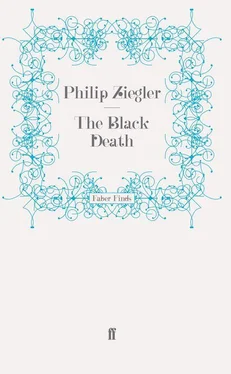I pray to God, so save thy gentil cors
And eek thyne urynals and thy jurdones,
Thyn ypocras and eek thy galiones.
And every boyste ful of thy letuarie. [2] God’s blessing on you, Doctor, not forgetting Your various urinals and chamber pots, Bottles, medicaments and cordial tots And boxes brimming all with panaceas.
Fourteenth-century men seem to have regarded their doctor in rather the same way as twentieth-century men are apt to regard their priest, with tolerance for someone who was doing his best and the respect due to a man of learning but also with a nagging and uncomfortable conviction that he was largely irrelevant to the real and urgent problems of their lives. They were, of course, ready to believe almost anything which was told them with authority but their faith had been undermined by the patent lack of confidence on the part of the doctors themselves. Sometimes, under intolerable stress, scepticism would give way to something more primitive and violent, tolerance would crack and the doctor find himself execrated as the architect of the disease which he had proved so signally ill-qualified to check. But such moments of revulsion were rare and in general the doctor preserved a privileged position. Chaucer’s mockery and the occasional abuse of an aggrieved patient was the worst that he had to bear.
* * *
However little use the doctors may have been, the average Parisian at least had the comfort of knowing that he was far better provided with medical attention than his contemporaries. There were more doctors, predominantly Jewish, in Paris than in any other city of Europe and all surgeons had passed an examination and had been licensed by a panel of master surgeons trained at the Châtelet. {139} 139 35 Siméon Luce, Bertrand de Guescelin, pp. 69–73.
The fashionable course for study was based on the works of the Arab surgeon Razi and an ointment called ‘ Blanc de Razès ’ was on sale at apothecaries as a cure recommended for virtually any ailment. But no amount of ointments nor the wisdom of the august Faculty of Medicine itself could do much to help the Parisian when the Black Death broke about him.
It seems that the first authenticated cases of plague in the capital were noted in May or June 1348, though the full force of the epidemic was not felt until several months later. It did not die out until the winter of 1349. The chronicler of St Denis put the death roll at about fifty thousand, {140} 140 36 cit. H. Martin, Histoire de France, Vol. V, p. 111.
a surprisingly conservative estimate for a city that may well have had more than two hundred thousand inhabitants. {141} 141 37 E. Carpentier and J. Glénisson, op. cit., p. 109.
Certainly there is no reason to think the figure exaggerated. An analysis based on church warden accounts for the parish of St Germain l’Auxerrois showed that seventy-eight legacies were bequeathed to the church between Easter 1340 and 11 June 1348. {142} 142 38 M. Mollat, ‘La Mortalité à Paris’, Moyen Age, Vol. 69, 1963, p. 505.
In the next nine months the number rose to four hundred and nineteen – a rate forty times as high. ‘It seems,’ commented Mollat, ‘that the plague sent men to their lawyers as fast as to their confessors.’ On this, admittedly somewhat slender basis, he calculated that the plague was at its worst almost at the end, in September and October 1349, and that it ran an unusually protracted course. The Bishop, Foulque de Chanac, died in July 1349; the Duchess of Normandy, Bonne de Luxembourg, in October and her mother-in-law, Jeanne de Bourgogne, when the danger must have seemed almost over, on 12 December.
‘There was,’ wrote the best-known chronicler of the Black Death in Paris, ‘so great a mortality among people of both sexes, of the young rather than of the old, that it was hardly possible to bury them.’ {143} 143 39 ‘Continuatio Chronici Guillelmi de Nangiaco’, Soc, de L’Histoire de France, Vol. II, 1844, pp. 211–17.
This is not the only reference to the plague striking the young rather than the old, the strong before the weak. Statistically, as will be seen more clearly in the case of England, {144} 144 40 p. 169 below.
there seems no reason to credit such a theory. The position is, of course, complicated by the tendency of the old to die from other causes without a major epidemic to speed them on their way, but, even after allowing for this, the young and fit, as was to be expected, proved the more likely to resist the disease. The death of a strong young man is naturally more shocking and more likely to be remembered: to this, perhaps, is due the conviction on the part of certain chroniclers that his chances of death were unfairly high.
‘In the Hôtel-Dieu at Paris,’ continued the chronicler, ‘so great was the mortality that for a long time more than five hundred corpses were carted daily to the churchyard of St Innocent to be buried.’ Cardinal Gasquet has suggested that this is a misprint for fifty. {145} 145 41 Black Death, p. 55, basing himself on Géraud.
Certainly the latter figure is probably nearer reality but there seems little reason to doubt that William of Nangis would have preferred the larger, more imposing total. ‘And those holy sisters,’ he continued, ‘having no fear of death, tended the sick with all sweetness and humility, putting all honour [sic ?fear] behind their back. The greater number of these sisters, many times renewed by death, now rest in peace with Christ, as we must piously believe.’ Such examples of self-abnegation were rare enough to deserve special mention; for the most part, in Paris as in every other city, the rule of the day was sauve-qui-peut. Charity, if it was to be found at all, began at home and ended there. Even the priests ‘retired through fear’, leaving the sick to shrive themselves or, if they were lucky, to gain the attention of a mendicant friar.
When the pastors set such an example it was hardly surprising that their flocks should follow suit. In the benighted city, where it seemed death to wander abroad, only those servants of death, the grave-diggers, felt themselves free to travel where they would. The rich and privileged fled, the poor remained to drown their fear in looted liquor and die in their hovels. Under the surface scum of terror and disorder ordinary decent men continued to behave in an ordinary, decent way; the life of the city fitfully continued. But to the casual visitor it must have seemed that society had disintegrated, that the plague must rage until there was not a home inviolated, not a Parisian alive. If it was not to be the end of the world, it seemed at least the end of the established order.
* * *
From Paris the plague moved northwards to the coast, which it reached in or a little before August 1348. In this area, exceptionally, the winter checked the violence of the epidemic but with the spring it returned, evidently in its more virulent pulmonary form. The King had fled from Paris to Normandy but the plague was quick to follow him. At Rouen, where an over-excited contemporary calculated the dead at a hundred thousand, the Duke of Normandy donated land for a new graveyard. At Bayeux the Bishop and many canons died. At La Graverie, about four miles from Vire, ‘the bodies of the dead decayed in putrefaction on the pallets where they had breathed their last.’ A black flag flew above the church as it did in all the worst affected villages of Normandy. {146} 146 42 L. Porquet, La Peste en Normandie, Vire, 1898, p. 77.
La Léverie was a village within the parish of La Graverie. The lady of the manor died and her relatives wished to bury her in the churchyard. But no priest of La Graverie remained alive to conduct the service and there was no sign of a new incumbent being appointed. The relatives appealed to the priest of neighbouring Coulonces who was happy to bury the deceased but drew the line at visiting La Graverie, because of the danger of infection, and was equally reluctant to accept the corpse in Coulonces for fear of contaminating his so far inviolate village. So this lady was buried in the park of her own manor and the grateful relatives arranged the transfer of La Léverie from the parish of La Graverie to the parish of Coulonces.
Читать дальше












